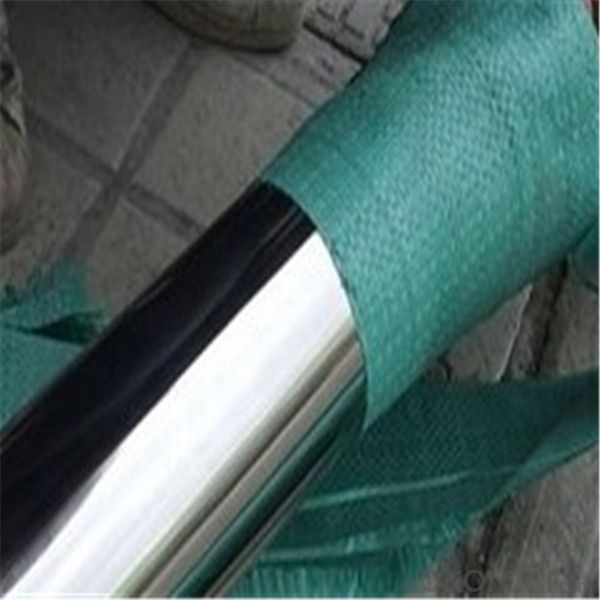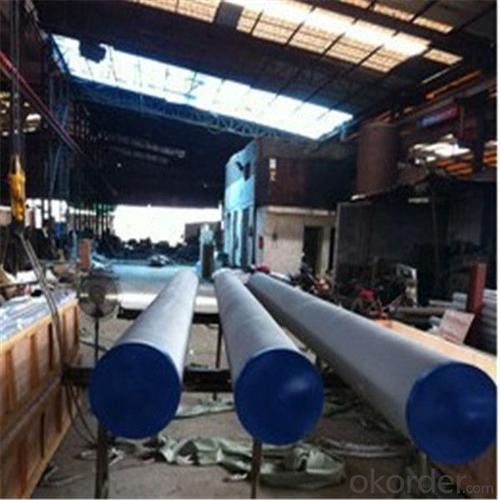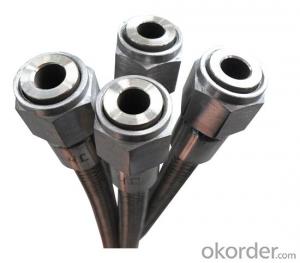A213 tp316l Stainless Steel Pipes/aisi 904l stainless steel pipe
- Loading Port:
- Shanghai
- Payment Terms:
- TT OR LC
- Min Order Qty:
- 6 m.t.
- Supply Capability:
- 25000 m.t./month
OKorder Service Pledge
OKorder Financial Service
You Might Also Like
Specification
316 stainless steel pipe
Product Description
Nominal Diameter(mm) | Outside Diameter(mm) | Nominal Wall Thickness (mm) | |||
N.B | NPS | SCH5S | SCH10S | SCH40S | |
8 | 1/4″ | 13.72 | 1.65 | 2.24 | |
10 | 3/8″ | 17.15 | 1.65 | 2.31 | |
15 | 1/2″ | 21.34 | 1.65 | 2.11 | 2.77 |
20 | 3/4″ | 26.67 | 1.65 | 2.11 | 2.87 |
25 | 1″ | 33.4 | 1.65 | 2.77 | 3.38 |
32 | 1-1/4″ | 42.16 | 1.65 | 2.77 | 3.56 |
40 | 1-1/2″ | 48.26 | 1.65 | 2.77 | 3.68 |
50 | 2″ | 60.33 | 1.65 | 2.77 | 3.91 |
65 | 2-1/2″ | 73.03 | 2.11 | 3.05 | 5.16 |
80 | 3″ | 88.9 | 2.11 | 3.05 | 5.49 |
90 | 3-1/2″ | 101.6 | 2.11 | 3.05 | 5.74 |
100 | 4″ | 114.3 | 2.11 | 3.05 | 6.02 |
125 | 5″ | 141.3 | 2.77 | 3.4 | 6.55 |
150 | 6″ | 168.28 | 2.77 | 3.4 | 7.11 |
200 | 8″ | 219.08 | 2.77 | 3.76 | 8.18 |
Tolerance :
Standard | GB151 ASTM JIS DIN | ||
OD | I | II | |
<Ø25---≥Ø50 | ±0.18 | ±0.30 | |
≥Ø25---≤Ø89 | ±0.30 | ±0.45 | |
≥Ø89---≤Ø129 | ±0.51 | ±0.80 | |
Thickness | All specifications±0.5% | ||
Length | All specifications±6 | ||
Straightness | All specifications≤2/1000 | ||
Chemical Composition:
Grade and Main chemical composition% | |||||||||
C | Si | Mn | P≤ | S≤ | Cr | Mo | Ni | Other | |
201 | ≤0.15 | ≤1.00 | 5.5-7.5 | 0.06 | 0.03 | 16-18 | - | 3.5-5.5 | N≤0.25 |
202 | ≤0.15 | ≤1.00 | 7.5-10.0 | 0.06 | 0.03 | 17-19 | - | 4.0-6.0 | N≤0.25 |
301 | ≤0.15 | ≤1.00 | ≤2.00 | 0.045 | 0.03 | 16-18 | - | 6.0-8.0 | - |
302 | ≤0.15 | ≤1.00 | ≤2.00 | 0.045 | 0.03 | 17-19 | - | 8-10.0 | - |
303 | ≤0.15 | ≤1.00 | ≤2.00 | 0.2 | ≥0.015 | 17-19 | ≤0.6 | 8.0-10.0 | - |
304 | ≤0.08 | ≤1.00 | ≤2.00 | 0.045 | 0.03 | 18-20 | - | 8-10.5 | - |
304L | ≤0.03 | ≤1.00 | ≤2.00 | 0.045 | 0.03 | 18-20 | - | 9-13 | - |
305 | ≤0.12 | ≤1.00 | ≤2.00 | 0.045 | 0.03 | 17-19 | - | 10.5-13 | - |
309S | ≤0.08 | ≤1.00 | ≤2.00 | 0.045 | 0.03 | 22-24 | - | 12-15 | - |
310S | ≤0.08 | ≤1.5 | ≤2.00 | 0.045 | 0.03 | 24-26 | - | 19-22 | - |
316 | ≤0.08 | ≤1.00 | ≤2.00 | 0.045 | 0.03 | 16-18 | 2-3 | 10-14 | - |
316L | ≤0.03 | ≤1.00 | ≤2.00 | 0.045 | 0.03 | 16-18 | 2-3 | 12-15 | - |
317 | ≤0.08 | ≤1.00 | ≤2.00 | 0.045 | 0.03 | 18-20 | 3-4 | 11-15 | - |
317L | ≤0.03 | ≤1.00 | ≤2.00 | 0.045 | 0.03 | 18-20 | 3-4 | 11-15 | - |
321 | ≤0.08 | ≤1.00 | ≤2.00 | 0.045 | 0.03 | 17-19 | - | 9-13 | Ti≥5×C |
405 | ≤0.08 | ≤1.00 | ≤1.00 | 0.04 | 0.03 | 11.5-14.5 | - | ≤0.6 | AL0.1-0.3 |
420F | 0.26-0.4 | ≤1.00 | ≤1.25 | 0.06 | ≥0.15 | 12-14 | ≤0.6 | ≤0.6 | - |
430 | ≤0.12 | ≤0.75 | ≤1.00 | 0.04 | 0.03 | 16-18 | - | ≤0.6 | |
Definition of stainless steel(Adopted form Wikipedia)
In metallurgy, stainless steel, also known as inox steel or inox from French "inoxydable",
is defined as a steelalloy with a minimum of 10.5% to 11% chromium content by mass.
Stainless steel does not readily corrode, rust or stain with water as ordinary steel does,
but despite the name it is not fully stain-proof, most notably under low oxygen, high salinity,
or poor circulation environments. It is also called corrosion-resistant steel or CRES
when the alloy type and grade are not detailed, particularly in the aviation industry.
There are different grades and surface finishes of stainless steel to suit the environment
the alloy must endure. Stainless steel is used where both the properties of steel
and resistance to corrosion are required.
Surface Finish :
Surface finish | Characteristics and application |
No.2B | The surface brightness and flatness of no2B is better than no2D. then through a special surface treatment to improve its mechanical properties, No2B could nearly satisfy comprehensive uses. |
No.3 | Polished with abrasive belt of git#100-#200, have better brightness with discontinuous coarse stria, used as inner and external ornaments for building, electrical appliances and kitchen utensils etc. |
No.4 | Polished with abrasive belt of grit #150-#180,have better brightness with discontinuous coarse stria, but thinner than No3, are used as bathtub buildings inner and external ornaments electrical appliances kitchen utensils and food processing equipment etc. |
HL | Polished with abrasive belt of grit #150-#320 on the NO.4 finish and has continuous streaks, mainly used as buildings ornaments elevators, door of building, frontal plate etc. |
BA | Cold rolled, bright annealed and skin-passed, the product have excellent brightness and good reflexivity like mirror, kitchen apparatus, ornament etc. |
8K | The product have excellent brightness and prefer reflexivity can to be the mirror. |


- Q:What are the cost considerations for stainless steel pipes?
- The cost considerations for stainless steel pipes include the initial purchase price, installation costs, maintenance expenses, and potential long-term savings due to their durability and corrosion resistance. Additionally, factors such as the grade, size, and quantity of pipes needed and any additional fabrication or customization requirements can also impact the overall cost.
- Q:Can stainless steel pipes be used in extreme weather conditions?
- Yes, stainless steel pipes can be used in extreme weather conditions. Stainless steel is known for its excellent corrosion resistance, which makes it ideal for withstanding harsh weather conditions such as extreme temperatures, high humidity, and exposure to saltwater or chemicals. Additionally, stainless steel pipes have high strength and durability, making them resistant to impact and deformation caused by extreme weather events like storms or earthquakes. Therefore, stainless steel pipes are often chosen for applications in industries such as oil and gas, chemical processing, and marine, where they need to perform reliably in extreme weather conditions.
- Q:What are the dimensions and sizes of stainless steel pipes?
- Different industrial and commercial applications are served by stainless steel pipes of varying dimensions and sizes. The sizing of these pipes is determined by their nominal diameter (DN) and the schedule or wall thickness. The nominal diameter represents the approximate internal diameter of the pipe and is commonly expressed in inches or millimeters. The most frequently available stainless steel pipe sizes range from 1/8 inch (3.175 mm) to 48 inches (1219 mm) in nominal diameter. However, larger sizes can be custom-made to meet specific requirements. The schedule or wall thickness of stainless steel pipes is indicated by a schedule number, which reflects the thickness of the pipe's walls. The most commonly used schedules for stainless steel pipes include Sch 5, Sch 10, Sch 40, and Sch 80. The higher the schedule number, the thicker the walls of the pipe. Apart from the dimensions and sizes, stainless steel pipes also come in various lengths, typically ranging from 20 feet (6.1 meters) to 40 feet (12.2 meters). Custom lengths can also be ordered based on specific project needs. It is important to note that these dimensions and sizes may differ based on the standards and specifications established by different countries and industries. Hence, it is crucial to consult the relevant standards or collaborate with a reliable supplier to ensure the precise dimensions and sizes of stainless steel pipes for a particular application.
- Q:Can stainless steel pipes be insulated with polyvinyl chloride?
- No, stainless steel pipes cannot be insulated with polyvinyl chloride.
- Q:Are stainless steel pipes suitable for offshore platforms?
- Yes, stainless steel pipes are suitable for offshore platforms. Stainless steel is a corrosion-resistant material that can withstand the harsh marine environment, including exposure to seawater, salt, and other corrosive agents. It offers excellent resistance to oxidation and pitting, which are common issues in offshore environments. Stainless steel pipes are widely used in offshore platforms for various applications, such as transporting fluids and gases, structural supports, and as protective barriers. They are known for their high strength, durability, and reliability, which are crucial factors in offshore operations where safety is of utmost importance. Furthermore, stainless steel pipes have low maintenance requirements, reducing the need for frequent inspections and repairs. This is particularly advantageous in offshore settings where accessibility and maintenance can be challenging due to remote locations and harsh weather conditions. In addition to its corrosion resistance, stainless steel also offers other desirable properties such as heat resistance, fire resistance, and excellent mechanical properties. These characteristics make stainless steel pipes an ideal choice for offshore platforms, where they can be exposed to high temperatures, fire hazards, and mechanical stress. Overall, stainless steel pipes provide a cost-effective and long-lasting solution for offshore platforms, ensuring the safety, reliability, and efficiency of operations in these challenging environments.
- Q:What is the standard size range for stainless steel pipes?
- The standard size range for stainless steel pipes typically varies from 1/8 inch to 48 inches in diameter.
- Q:Can stainless steel pipes be insulated with polybutylene?
- Polybutylene, a plastic material frequently utilized for water supply pipes, is not viable for insulating stainless steel pipes. These pipes, already remarkably corrosion-resistant, do not necessitate additional insulation for thermal purposes. In the event that insulation becomes essential for stainless steel pipes, alternative materials like fiberglass or foam pipe insulation may be employed.
- Q:Can stainless steel pipes be used for HVAC systems?
- Yes, stainless steel pipes can be used for HVAC (Heating, Ventilation, and Air Conditioning) systems. Stainless steel is a widely used material in HVAC applications due to its durability, corrosion resistance, and high heat resistance. Stainless steel pipes are able to withstand high temperatures and pressures, making them suitable for both heating and cooling systems. Additionally, stainless steel pipes do not rust or corrode easily, which ensures a longer lifespan and minimal maintenance requirements for HVAC systems. The smooth interior surface of stainless steel pipes also allows for better airflow, which improves the efficiency of the HVAC system. Overall, stainless steel pipes are a reliable and efficient choice for HVAC installations.
- Q:What is the difference between seamless and precision stainless steel pipes?
- The main difference between seamless and precision stainless steel pipes lies in their manufacturing processes. Seamless stainless steel pipes are made by piercing a solid stainless steel billet, while precision stainless steel pipes are created by cold rolling and cold drawing processes. This results in seamless pipes having a smoother internal surface and higher dimensional accuracy, making them suitable for applications requiring high-pressure and corrosive environments. On the other hand, precision stainless steel pipes are commonly used in industries where tight tolerances and precise dimensions are crucial, such as automotive and aerospace sectors.
- Q:What is the corrosion resistance of stainless steel pipes?
- Due to the presence of chromium in their composition, stainless steel pipes possess excellent corrosion resistance. The chromium in these pipes undergoes a reaction with oxygen in the atmosphere, resulting in the formation of a thin layer of chromium oxide on the pipe's surface. This layer of oxide acts as a protective barrier, effectively preventing further oxidation and corrosion of the underlying metal. Moreover, stainless steel pipes often incorporate other elements such as nickel and molybdenum, which further bolster their resistance against corrosion. Consequently, stainless steel pipes exhibit remarkable resistance to rust, pitting, and other forms of corrosion, rendering them suitable for a wide array of applications in diverse industries, including plumbing, oil and gas, chemical processing, and marine environments.
1. Manufacturer Overview |
|
|---|---|
| Location | |
| Year Established | |
| Annual Output Value | |
| Main Markets | |
| Company Certifications | |
2. Manufacturer Certificates |
|
|---|---|
| a) Certification Name | |
| Range | |
| Reference | |
| Validity Period | |
3. Manufacturer Capability |
|
|---|---|
| a)Trade Capacity | |
| Nearest Port | |
| Export Percentage | |
| No.of Employees in Trade Department | |
| Language Spoken: | |
| b)Factory Information | |
| Factory Size: | |
| No. of Production Lines | |
| Contract Manufacturing | |
| Product Price Range | |
Send your message to us
A213 tp316l Stainless Steel Pipes/aisi 904l stainless steel pipe
- Loading Port:
- Shanghai
- Payment Terms:
- TT OR LC
- Min Order Qty:
- 6 m.t.
- Supply Capability:
- 25000 m.t./month
OKorder Service Pledge
OKorder Financial Service
Similar products
New products
Hot products
Hot Searches
Related keywords
































